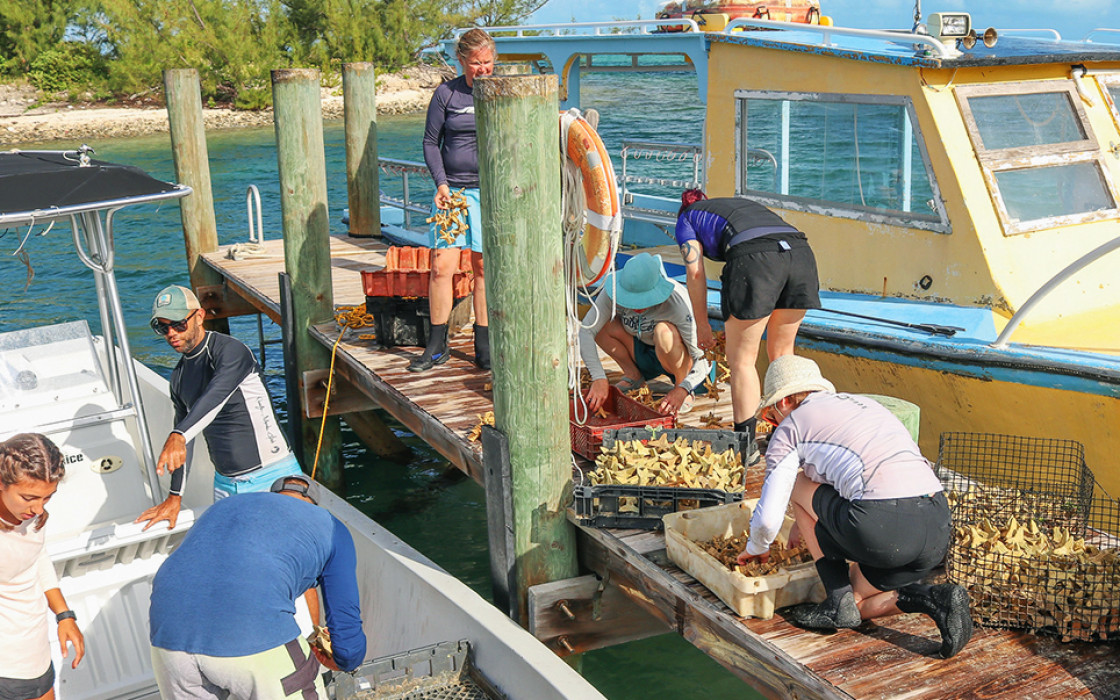Coral breeding success in floating mesocosms pushes restoration towards large-scale implementation
Published at: August 30th, 2021 by Carin JantzenSECORE develops techniques for sustainable and diverse coral restoration on larger scales. Breeding large numbers of coral offspring from natural spawning events within floating mesocosms has now proved successful among Caribbean locations.
In the last decade, coral restoration has become a mandatory tool to counteract coral reefs' fatal decline.
Coral reefs' dire status has become more and more apparent to the wider public via reports of re-occurring global bleaching and disease events and subsequent mass die-offs of corals during the last decade. In their recently published policy paper, the International Coral Reef Society urges politicians and decision makers to take immediate action. "The next ten years offer the last chance to change the trajectory of coral reefs from heading towards world-wide collapse to heading towards slow but steady recovery" (Rebuilding Coral Reefs, Knowlton, et al. 2021). Apart from reversing global threats―above all mitigating climate change―and reducing local stressors, restoration has become an essential tool for coral reef management. Or, plainly spoken, a tool to give these vital ecosystems a fighting chance to survive into the next century.
SECORE International develops techniques to use sexually bred corals for sustainable, biodiverse coral restoration on larger scales, taking advantage of both scientists and engineers working in concert, as well as strong cooperation with partners worldwide. Breeding corals may be broken down into three simplified steps: I.) collecting coral spawn during natural spawning events and facilitating its fertilization; II.) culturing coral larvae to settle and metamorphose into coral polyps; III.) placing the young corals back into the wild.
A recent publication by SECORE scientists and co-authors at UNAM (National Autonomous University of Mexico) and Shedd Aquarium (US) in the peer-reviewed journal Restoration Ecology shows significant success in closing the gap to scale by settling many thousands of coral larvae in floating mesocosms (Settlement yields in large-scale in situ culture of Caribbean coral larvae for restoration, Miller, Latijnhouwers, et al. 2021). These mesocosms are called Coral Rearing In-situ Basins, or CRIBs, and can be used to produce large numbers of coral recruits without the need for land-based lab or aquaculture facilities. Hence, they can be applied in many locations where coral restoration is needed, but facilities are few.
"They are a safe place to support the coral babies through their first fragile life stages, including the radical change of a free-swimming coral larva turning into a sessile animal that eventually will grow into a coral colony," explains Kelly Latijnhouwers, SECORE's Caribbean Restoration Coordinator. The research also shows that the CRIBs provide similar efficiency of converting coral embryos to settlers as is seen in land-based lab or aquaculture tanks and can be successful in a range of locations and for at least five different coral species. Nevertheless, this is only one aspect of the whole process of sexually breeding corals for restoration that SECORE and partners are developing. For instance, the coral larvae are settled on specifically designed substrates that can be handled easily and are self-stabilizing on the reefs when brought back into the wild, thus avoiding the need for labor-intensive active attachment.
Working with coral breeding, using the corals' own reproduction, not only provides the potential to raise huge numbers of coral babies out of each natural spawning event, but also promotes genetic diversity in the restored population. With the possibility of genetic recombination, some genotypes may arise that can better cope with our rapidly changing environmental conditions than their struggling and dying parents. It is hoped that future restoration efforts can utilize selectively-bred or stress-hardened coral recruits, which, for instance, may cope with elevated sea water temperatures. "SECORE's work to develop techniques to effectively scale-up spawn collection, larval production, and outplanting the coral recruits will be key to implementing these breeding interventions in the near-future," emphasizes Margaret Miller, SECORE's Research Director.
A network of implementation partners, trained and mentored by SECORE, is spreading the coral breeding approach successfully.

“SECORE is one of the few organizations capable of addressing the needs to close the gap to scale for coral restoration, because of our innovative tools and techniques, and our expanding partner network”, says Dirk Petersen, SECORE's founder and Executive Director. “I feel a great responsibility and urgency in this race against irreversible loss. We need to advance our scientific research, technology development, and training and implementation programs at a much faster pace, because every single coral spawning event is crucial in this race against time.”
